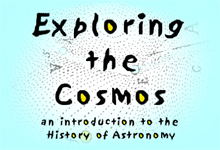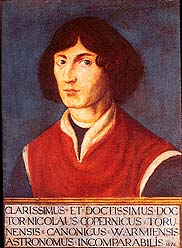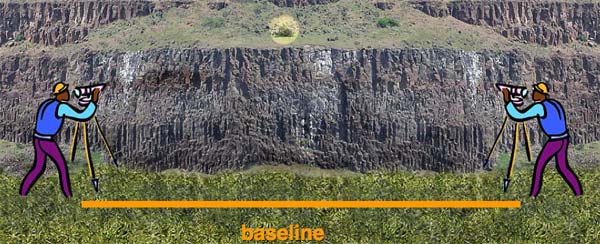

Department of History
University of California, Irvine
Instructor: Dr. Barbara J. Becker
![]()
Lecture 4. The Copernicans.
![]()
|
|
The Julian calendar, first used in 45 BCE, is named for Julius Caesar who, after consultation with the Alexandrian astronomer Sosigenes, ordered a major reform of the unwieldy and often corrupt calendrical system then in use. The Julian calendar was based on the cycle of the Sun's apparent motion through the fixed stars. Designed to be self-adjusting, it needed little or no human meddling to remain tuned in to the regular cycle of the seasons. Its rules were simple enough that everyone throughout the Empire could follow without confusion: most years were set to be 365 days long; every year divisible by four was 366 days long.
The sidereal year is a little longer than the civil year (about 9 min 10 sec). In time (over 157 years), that difference would add up to a full day. An extra day would have to be added every 157 years to keep the civil and sidereal calendars in synchrony. But, it turns out that things are a bit more complicated. The Earth not only rotates on its axis -- like every spinning top -- but while it rotates, its axis of rotation exhibits a slow wobbling motion called precession. Thus the Earth's north and south poles are not permanently fixed in their orientations with respect to the stars. The angle of the Earth's tilt stays nearly the same (23.5°), but the direction in which they point is constantly changing. The illustration below shows the large circular path that the north polar axis traces out on the sky as it wobbles. About four thousand years ago, the north polar axis pointed near the star Thuban in the constellation Draco. In recent years it has been pointing closer and closer to Polaris in Ursa Minor. In 2017 the Earth's north polar axis will be aligned most closely to Polaris. After that, as Earth continues its slow wobble, the north polar axis will begin pointing a little farther away from the star that has served as the Pole Star for modern navigators. Twelve thousand years from now the north polar axis will point near the bright star Vega. In about 26,000 years, it will point toward Polaris again. Because of Earth's precession, a civil calendar -- even one that is well-tuned to keep pace with the sidereal year -- will drift seasonally.
Today the constellation Orion is visible during the northern hemisphere's winter months. People living 6500 years from now will associate Orion's appearance in the night sky with the beginning of spring. As the illustration above shows, Orion will be a familiar summer constellation in 13,000 years. If we used a civil calendar linked to the sidereal year, all of these events would take place in the month we call December. Regardless of the season, December would always be Orion time. Astronomers may find the sidereal year to be a convenient unit of time to use, but it has generally proved more practical for most people to wed the civil calendar to a measure of the seasonal year -- the time from winter solstice to winter solstice, or vernal equinox to vernal equinox.
Notice that the tropical year is shorter than the sidereal year (by 20 min 24 sec). And it is 11 min 14 sec shorter than the civil calendar, a difference which adds up to roughly one day every 130 years. No adjustments were made to the civil calendar Julius Caesar instituted to account for the fact that it is just a little bit too long. Over time, the difference between the civil year and the tropical year became increasingly significant:
By the 1500s, the discrepancy between the seasonal calendar and the civil calendar had become problematic, particularly for Christian church leaders:
|
|||||||||||||||||||||||||||||
Postscript on calendar reform: The Gregorian Calendar In 1582, Pope Gregory XIII decreed that in the Catholic Christian world, October 4, 1582 would be followed by October 15. He took this drastic action to bring the civil and seasonal calendars back into sync by realigning the vernal equinox with a part of the civil calendar that had been traditionally associated with the beginning of spring -- around the 20th of March. To prevent such disparities from building up in the future, he modified the rule for determining leap years. In the Julian calendar, every year that is divisible by four is a leap year. But that practice clearly inserts too many days. How many? Over a 400-year period, it will add three extra days. So every 400 years, three days must be eliminated to keep the civil calendar in seasonal alignment. How to choose those three days? Gregory decreed that century years would no longer be designated as leap years -- unless they were divisible by 400!
|
|
Revolutionary, or Reactionary? |

|
|
Notable Events in Copernicus's Life |
|
| 1473 | born in Torun, Prussia (present-day Poland) |
| 1491 | enrolled at University of Cracow studied church law |
| 1496 | enrolled at University of Bologna studied Greek, philosophy, astronomy, medicine |
| 1500 | summoned to Rome for symposium on calendar reform |
| 1501 | enrolled at University of Padua; studied law and medicine |
| 1503 | returned to Torun; served as physician, cleric, scholar |
| 1514 | circulated treatise called Commentariolus (Little Commentary) among his friends |
|
Commentariolus (1514) by Nicholas Copernicus The planetary theories of Ptolemy and most other astronomers, although consistent with the numerical data, seemed likewise to present no small difficulty. For these theories were not adequate unless certain equants were also conceived ... a system of this sort seemed neither sufficiently absolute, nor sufficiently pleasing to the mind.Copernicus's assumptions in Commentariolus:
|
|
Notable Events in Copernicus's Life (cont'd) |
| 1538 | Georg Joachim Rheticus (1514-1575) arrived in Torun to study with Copernicus |
| 1540 | Rheticus published Narratio Prima (First Account) |
| 1541 | Rheticus encouraged Copernicus to prepare his treatise for publication |
| 1542 (May) | manuscript taken to printer in Nuremberg
Rheticus unable to oversee publication task taken over by Andreas Osiander |
| 1542 (Dec) | Copernicus suffered cerebral hemorrhage |
| 1543 (May) | publication of De Revolutionibus completed
Copernicus died shortly afterwards |
|
|
|
|
|
|
|
Why change?
Determining Relative Planetary Distances from the Sun in Copernicus's Heliocentric System |
|
In Copernicus's system, the orbits of Mercury and Venus are closer to the Sun than Earth's. An earthbound observer who begins to watch Venus on a daily basis when the planet first appears in the evening sky after sunset will notice the planet appear to move farther and farther away from the Sun over a period of months until the two bodies reach a maximum separation -- Venus's "angle of greatest elongation" (46°). Then, over time, Venus will appear to move closer to the Sun once again. The same is true for Mercury, but its angle of greatest elongation is far smaller (27°) than that of Venus. Copernicus believed this demonstrated that Mercury was always closer to the Sun than Venus.
Here is how Venus's path around the Sun appears from far above the orbital plane: 
Distance of Venus from the Sun (Sun-Earth distance = 1 AU) Notice that, from the point of view of an earthbound observer, Venus's greatest elongation occurs when the planet is located on the line of sight that lies tangent to its orbital path. Copernicus argued that an astronomer who knew Venus's and Mercury's angles of greatest elongation could apply simple geometric principles to determine the relative distances of these planets from the Sun compared to that of Earth.
________________
Mars, Jupiter and Saturn are not tied to the Sun like Mercury and Venus. To determine relative distances from the Sun to these planets, Copernicus took advantage of his claim that the Earth itself is in motion. Earthbound observers view the other planets from an ever-changing vantage point. Terrestrial surveyors use this technique to determine the distance to an inaccessible object. |

Determining the distance to the tree on the other side of the canyon would be impossible if the
surveyor was restricted to viewing it from only one vantage point.
It is an easy task for a mobile
surveyor
who can mark out a long baseline and then view the tree from each end of the baseline.

The surveyor uses simple geometric principles to triangulate the distance to the tree.
|
Copernicus reasoned that an earthbound observer could determine the relative distance from the Sun to Mars by viewing the planet from two ends of a long baseline. The baseline is established by first making one observation of Mars's precise position with respect to the fixed stars. One martian year later, when Mars has returned to its original position, the Earth, which moves around the Sun faster than Mars, will be located in a different point in its own orbit. The observer will now be able to view Mars from a new and different vantage point and triangulate the relative distance from the Sun to Mars.
Distance of Mars from the Sun (Sun-Earth distance = 1 AU) |
|
|
|
|
|
|
|
|
|
|
|
|
|
|
|
|
|
|
|
|
|
|
|
|
|
|
|
|
|
|
|
|
|
|
|
|
|
|
|
|
|
|
|
|
Copernicus's system of the world from de Revolutionibus Orbium Coelestium (1543)
|
|
|
The world system of Copernicus....
...or that of Ptolemy?
|
Response to the Copernican System |
|||
|
by Guillaume du Bartas (1544-1590)
from The Apology for Raimond de Sebonde (1580) [Natural] philosophy is nothing but sophisticated poetry.... Just as women use false teeth when their real ones drop out, and in place of a natural complexion lay on a manufactured one, and round out their figures with cotton stuffing, so ... science pays us with hypotheses which it confesses are pure invention. These epicycles with which astronomy moves the stars are merely the best devices it can contrive.... It was the stars and the heavens that were in motion for three thousand years. Or so everyone believed.... Now, in our time, Copernicus has so firmly established [that the earth moves, not the stars] that it serves everything we can observe astronomically. What shall we conclude from this, except that it is hardly worth while to heat ourselves up over one or the other? Who knows but what in a thousand years from now a third opinion will not supplant them both? [As Lucretius has written (Book V, On the Nature of Things:] Thus time as it goes round changes the seasons of things. That which was in esteem, falls at length into utter disrepute; and then another thing mounts up and issues out of its degraded state and every day is more and more coveted and blossoms forth high in honor when discovered and is in marvellous repute with men. from Theater of Universal Nature (1597) No one in his sense, or imbued with the slightest knowledge of physics, will ever think that the earth, heavy and unwieldy from its own weight and mass, staggers up and down around its own center and that of the sun; for at the slightest jar of the earth, we would see cities and fortresses, towns and mountains thrown down.... For if the earth were to be moved, neither an arrow shot straight up, nor a stone dropped from the top of a tower would fall perpendicularly, but either ahead or behind.... Lastly, all things on finding places suitable to their natures, remain there, as Aristotle writes. Since therefore the earth has been allotted a place fitting its nature, it cannot be whirled around by other motion than its own.
|
|